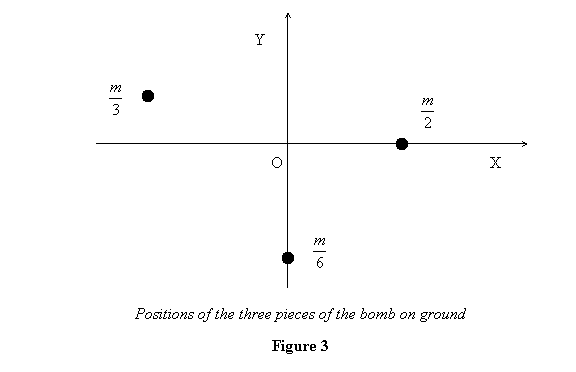Let us take an example.
Example 1: Suppose
a bomb dropping vertically down explodes in mid air and
breaks into three parts. Let the mass of the bomb be m and
those of three pieces  ,
respectively. If the heaviest piece falls 10m to
the east and the lightest piece 12m south of
where the unexploded bomb would have dropped, where does
the third piece fall? ,
respectively. If the heaviest piece falls 10m to
the east and the lightest piece 12m south of
where the unexploded bomb would have dropped, where does
the third piece fall?
Since  the
CM keeps on moving - even after the bomb breaks - vertically
down as if it were a point mass of mass M falling
under gravity. Thus the CM hits the ground where
the unexploded bomb would have fallen. Let us take
this point to be the origin with east side being
the positive x-axis and the north side the positive
y-axis. Then the
CM keeps on moving - even after the bomb breaks - vertically
down as if it were a point mass of mass M falling
under gravity. Thus the CM hits the ground where
the unexploded bomb would have fallen. Let us take
this point to be the origin with east side being
the positive x-axis and the north side the positive
y-axis. Then  after
the bomb pieces having moved for equal times. By
definition of the centre of mass we have after
the bomb pieces having moved for equal times. By
definition of the centre of mass we have

With  ,
this gives ,
this gives

Relative positions of the three pieces are shown in figure
3 below, with the centre of mass at the origin.

You see that having the knowledge about the position of
the other two pieces, we have got the position of the
third piece without the knowing anything about the forces
generated during the explosion and therefore without
solving any equation of motion. That is the power of
the momentum conservation principle. I will leave it
for you to think which component of momentum is conserved
in this case. Would that component be conserved if drag
force were included?
Other familiar examples of momentum conservation are a
gun recoiling when fired, two persons on roller seats
pushing each other and consequently moving away from
each other. Look around and you will find many such examples
of momentum conservation.
|